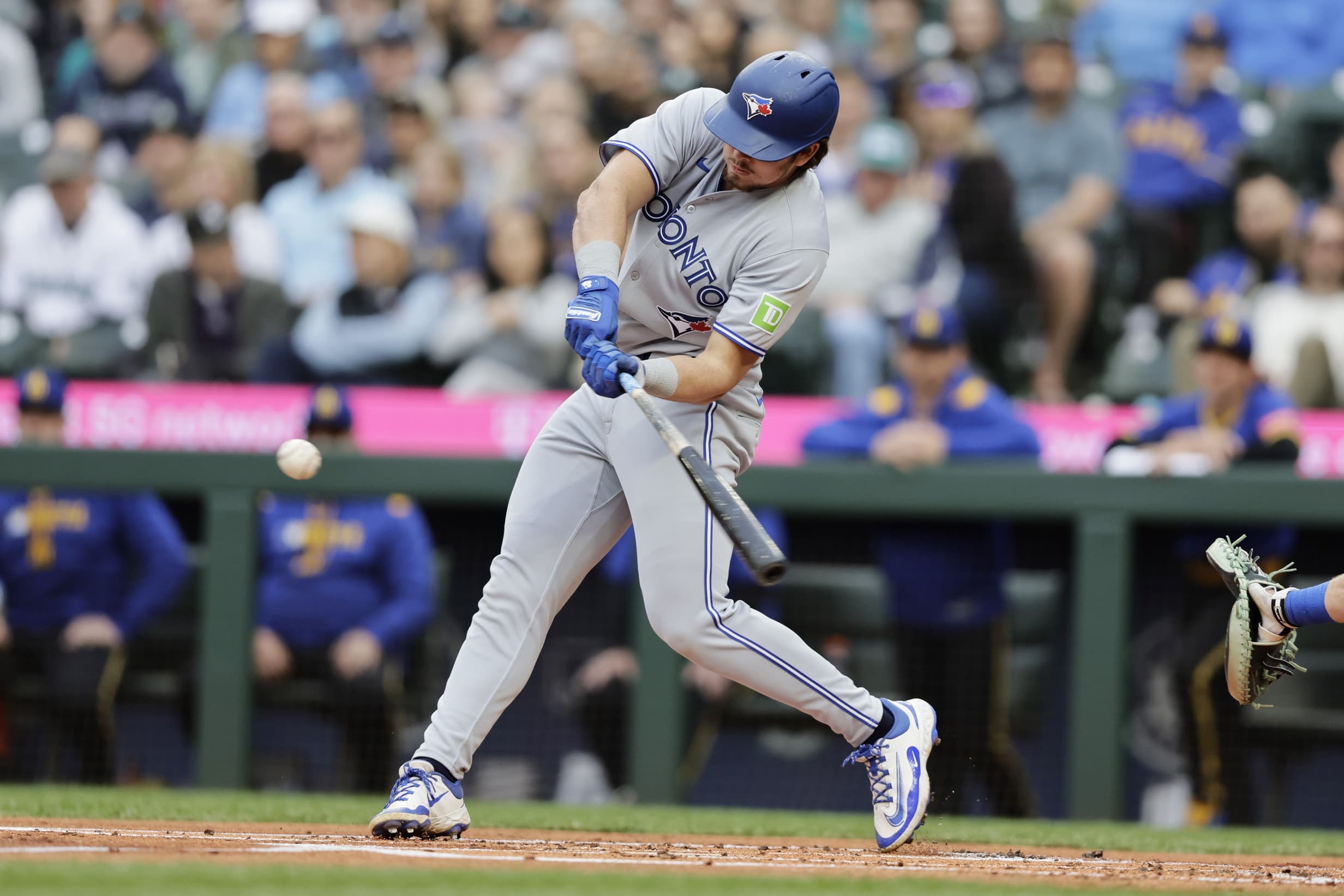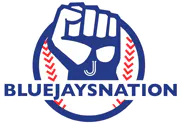ROSTER MOVES: UTIL Addison Barger and OF Steward Berroa have been optioned to Triple-A. The following players have been reassigned to Minor League camp: 🔹 C Christian Bethancourt 🔹 LHP Eric Lauer 🔹 C Ali Sánchez 🔹 INF Michael Stefanic Additionally, LHP Ryan Yarbrough
A consistent Addison Barger might be the spark plug the Blue Jays need

Photo credit: © John Froschauer-Imagn Images
May 10, 2025, 16:16 EDT
Looking back at the Blue Jays’ spring training roster decisions earlier this year, it was tough to see why Addison Barger was not heading to Toronto to begin the season. The lefty bat posted a .367/.429/.733 slash line and collected five extra base hits in 30 at-bats on his way to a 1.162 OPS, yet it wasn’t enough to sway the Jays staff to keep him around.
Under the surface, the move was not because Barger wasn’t playing well, but more rooted in how his playing time was going to shake out.
The club was without Daulton Varsho in centre field to begin the campaign and was using a trio of players in Myles Straw, Nathan Lukes, and George Springer in the spot, while also using Springer in the corner outfield spots in combination with Anthony Santander. Alan Roden also edged Barger out for a spot in left field with his dominant spring performance, as did Davis Schneider and his spring, but again, it wasn’t because the club didn’t think Barger was worthy of the opportunity; it more so boiled down to his playing time. The third baseman/corner outfielder was competing with a host of others for an opportunity to play, and there wasn’t guaranteed playing time for him in Toronto compared to Buffalo, so the team decided that it was better for him to play there than ride the bench with some sporadic playing.
Fast forward to April 15th, and the Jays were already calling on Barger to return to the big leagues. Lukes was heading to the paternity list, so the 25-year-old was staying around for a few days, but when the outfielder returned with the baby in tow, it was Schneider being sent down over Barger. The New Jersey product was struggling at the plate, and the Jays needed a change, so Barger remained.
Looking at his stat line and game log, it took some time for Barger to figure things out in 2025. He didn’t secure a hit until his fifth game and 13th at-bat, a double to right field that left the bat at 106.9 MPH, with Barger later crossing home plate on a Tyler Heineman single. He captured four hits over his next five games, which culminated from two games against the Yankees where he went 2 for 4 and 2 for 2, respectively, raising his average to .217 at the time. He also made waves on the defensive side of the game, showcasing his arm from right field against the Seattle Mariners, which resulted in three outfield assists, tying a franchise record for outfield assists in a single game.
Entering the Angels series earlier this week, Barger was hitless in his five previous games dating back to the Boston Red Sox series. He had three strikeouts under his belt through the 13 at-bats and was playing sporadically, starting games but getting pinch-hit further in based on the pitching matchups with the opposing relief corps. The contact was there, with Barger posting an exit velocity over 95 MPH on three of the balls hit in play during those 13 ABs, while his weakest hit balls were a pop-up and a forceout on the infield that left the bat at 83.6 MPH, but the results weren’t following.
It all felt similar to Barger’s debut stint with the Jays last season, where he went 1 for 18 at the plate (.056) and struck out six times. The big league pitchers were finding ways to get him out and he wasn’t able to adjust appropriately, eventually getting sent back to triple-A. He would return in mid-June for roughly one month before heading back down to Buffalo again. He would return in late July once the Jays had thrown in the towel and traded away numerous veteran players, and he found a ton of playing time, suiting up in 48 games down the stretch. That finish to the year consisted of 145 at-bats, posting a .214/.277/.414 line with a .691 OPS. The SLG numbers were intriguing, especially since he mashed eight doubles and seven home runs – 48.4% of his hits – and showed that when he could square up the ball, it could travel a long way.
The moment that stood out was his walk-off home run against the Angels on August 23rd. He worked a full count against Roansy Contreras in the ninth inning and sent a ball just foul of the pole in right field. The pitch was a 93 MPH fastball inside. Barger adjusted at the plate, and when Contreras threw 89 MPH down in the zone and he crushed the offering over the right centre field wall, sending the Jays fans home happy.
Looking back to earlier this week, Barger seemed like a potential candidate to head back to Buffalo, as he was working with a .139/.205/.222 line heading into the Angels series. The same size was small (14 games/36 at-bats), but the Jays were struggling to find clutch hits. A power bat like Barger was not pulling his weight, even though three of his five hits were doubles. A .427 OPS is hard to justify, even if his rocket of an arm is a key part of the equation.
Since the west coast swing earlier this week, Barger has found some rhythm at the plate, collecting a hit in his last three contests and going 3 for 4 in yesterday’s outing against the Mariners, providing a much-needed spark to start the game.
With the bases loaded in the first inning with one out, Barger smashed a changeup from Luis Castillo down to right field and plated two runs, a 109.7 MPH offering that the bat caught all of on the line drive. It was a moment that Jays fans had been waiting for, considering the missed opportunities dating back to the previous weekend against the Guardians. Barger’s two other hits were doubles as well, flying off the bat at 113.4 MPH and 116.5 MPH, respectively. He swings the bat hard, with his average bat speed this season sitting at 76.1 MPH – 4.5 MPH faster than the MLB average – and when he connects on the ball, it travels a long way. 63.4% of his swings this year are above the 75 MPH mark as well, and that game against the Mariners now has his season totals sitting at .222/.286/.356 with a .642 OPS.
There are still some areas that Barger needs to work on, but the Jays appear to have full confidence in his abilities despite some of the box score stats being on the low side. With the recent injury to Andres Gimenez, Barger is going to get considerable work at third base with Ernie Clement shifting over to second to cover. Should the Jays wish to put Michael Stefanic into some game action with Clement’s bat in the game, Barger could suit up in the outfield as well.
Addison Barger’s avg exit velocity is equal to Aaron Judge’s & Rafael Devers’… Only Shohei Ohtani & Oneil Cruz hitting the ball harder. That will play.
This is a prime opportunity for the Washington product to get into a good rhythm at the plate and continue to mash the ball with his quick bat, proving that he should continue to get regular reps even when Gimenez returns from the injured list. The Jays need all the run support they can get, and to have Barger start adding some home runs to his game would go a long way for this club, especially since we know what he can do with his arm and when he connects with the bat. He’s even impressed early with his work at third base, with no errors to his name after 41 1/3 innings at the hot corner despite shaky history at the position (even in the minors).
Looking ahead, Barger has a ton of raw talent that the Jays are looking to get the most out of this season and beyond. While some of his box score stats might not reflect this, if he can continue to make solid contact and put the barrel to the ball similar to last night’s performance, the Blue Jays might have found their answer for the additional power bat this club desperately needs. Consistency will be the biggest determining factor and whether he can shake the limited sample size rhetoric moving forward, but the hopeful outcome is that regular playing time will help shake off the cobwebs and provide that spark the Jays need to continue to win ballgames.
Breaking News
- Blue Jays outright Yariel Rodriguez from 40-man roster
- Blue Jays draftee Chase Brunson ranks on MLB Pipeline’s recent top 100 draft list
- Former Blue Jay Will Robertson claimed off waivers by the Orioles
- Chatting with Blue Jays prospect Reece Wissinger ahead of his first pro season
- The Blue Jays shouldn’t hesitate to pay Kyle Tucker like a superstar


